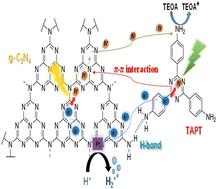当前位置:
X-MOL 学术
›
Catal. Sci. Technol.
›
论文详情
Our official English website, www.x-mol.net, welcomes your
feedback! (Note: you will need to create a separate account there.)
g-C3N4 coupled with 2,4,6-tris(4-aminophenyl)-1,3,5-triazine via π–π interactions enhanced visible-light photocatalytic H2 evolution from water splitting
Catalysis Science & Technology ( IF 4.4 ) Pub Date : 2023-08-23 , DOI: 10.1039/d3cy00837a Chen-Chuang Li 1 , Ikram Ullah 1 , Gang Wang 1 , An-Wu Xu 1
Catalysis Science & Technology ( IF 4.4 ) Pub Date : 2023-08-23 , DOI: 10.1039/d3cy00837a Chen-Chuang Li 1 , Ikram Ullah 1 , Gang Wang 1 , An-Wu Xu 1
Affiliation

|
Graphitic carbon nitride (g-C3N4) is an attractive candidate among the most promising metal-free photocatalysts under visible light for solar-to-fuel production. Nevertheless, the low photocatalytic performance and fast recombination rate of photoinduced charge carriers prevent its practical applications. Therefore, the integration of g-C3N4 with an appropriate material is highly desirable for enhancing H2 production. In this work, we report a TAPT/CN composite photocatalyst formed from g-C3N4 and 2,4,6-tris(4-aminophenyl)-1,3,5-triazine (TAPT) through π–π interactions and hydrogen bonds to enhance the photocatalytic activity. The small TAPT molecules act as a hole relay and thus elevate the transfer rate of holes from g-C3N4 to triethanolamine (TEOA); this in turn favors more electron transfer to the Pt cocatalyst and finally promotes the visible-light-driven H2 generation. The experimental results display that photocatalytic activity is greatly boosted by TAPT molecules in TAPT/CN nanoheterostructures. The optimized 5% TAPT/CN (5 wt% TAPT loading) sample achieves a maximum H2 evolution rate of 99.54 μmol h−1, which is 7.1 times higher than that of bare g-C3N4 (14.01 μmol h−1). Additionally, there is no significant decrease in H2 production after five consecutive cycles of continuous visible-light irradiation of up to 20 hours. We expect that this research will open the door to designing other organic material-decorated g-C3N4 photocatalysts for potential applications in solar-to-hydrogen energy conversion.
中文翻译:

g-C3N4 与 2,4,6-三(4-氨基苯基)-1,3,5-三嗪通过 π-π 相互作用增强可见光光催化水分解产氢
石墨氮化碳(gC 3 N 4)是可见光下用于太阳能转化燃料生产的最有前途的无金属光催化剂中最有吸引力的候选者。然而,低光催化性能和光生载流子的快速复合速率阻碍了其实际应用。因此,gC 3 N 4与适当材料的结合对于提高H 2产量是非常需要的。在这项工作中,我们报道了一种由 gC 3 N 4形成的 TAPT/CN 复合光催化剂2,4,6-三(4-氨基苯基)-1,3,5-三嗪(TAPT)通过π-π相互作用和氢键增强光催化活性。小 TAPT 分子充当空穴中继,从而提高空穴从 gC 3 N 4到三乙醇胺 (TEOA) 的转移速率;这反过来又有利于更多的电子转移到 Pt 助催化剂,并最终促进可见光驱动的 H 2生成。实验结果表明,TAPT/CN纳米异质结构中的TAPT分子大大提高了光催化活性。优化后的5% TAPT/CN(5 wt% TAPT负载)样品的最大H 2析出速率为99.54 μmol h -1,比裸gC 3 N高7.1倍4(14.01μmol h -1)。此外,在长达20小时的连续可见光照射的五个连续循环后, H 2产量没有显着下降我们预计这项研究将为设计其他有机材料装饰的 gC 3 N 4光催化剂打开大门,以用于太阳能到氢能转换的潜在应用。
更新日期:2023-08-23
中文翻译:

g-C3N4 与 2,4,6-三(4-氨基苯基)-1,3,5-三嗪通过 π-π 相互作用增强可见光光催化水分解产氢
石墨氮化碳(gC 3 N 4)是可见光下用于太阳能转化燃料生产的最有前途的无金属光催化剂中最有吸引力的候选者。然而,低光催化性能和光生载流子的快速复合速率阻碍了其实际应用。因此,gC 3 N 4与适当材料的结合对于提高H 2产量是非常需要的。在这项工作中,我们报道了一种由 gC 3 N 4形成的 TAPT/CN 复合光催化剂2,4,6-三(4-氨基苯基)-1,3,5-三嗪(TAPT)通过π-π相互作用和氢键增强光催化活性。小 TAPT 分子充当空穴中继,从而提高空穴从 gC 3 N 4到三乙醇胺 (TEOA) 的转移速率;这反过来又有利于更多的电子转移到 Pt 助催化剂,并最终促进可见光驱动的 H 2生成。实验结果表明,TAPT/CN纳米异质结构中的TAPT分子大大提高了光催化活性。优化后的5% TAPT/CN(5 wt% TAPT负载)样品的最大H 2析出速率为99.54 μmol h -1,比裸gC 3 N高7.1倍4(14.01μmol h -1)。此外,在长达20小时的连续可见光照射的五个连续循环后, H 2产量没有显着下降我们预计这项研究将为设计其他有机材料装饰的 gC 3 N 4光催化剂打开大门,以用于太阳能到氢能转换的潜在应用。

































 京公网安备 11010802027423号
京公网安备 11010802027423号